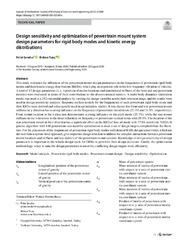Design sensitivity and optimization of powertrain mount system design parameters for rigid body modes and kinetic energy distributions
| dc.contributor.author | Şendur, Polat | |
| dc.contributor.author | Tunç, B. | |
| dc.date.accessioned | 2020-11-13T09:20:37Z | |
| dc.date.available | 2020-11-13T09:20:37Z | |
| dc.date.issued | 2020-08-24 | |
| dc.identifier.issn | 1678-5878 | en_US |
| dc.identifier.uri | http://hdl.handle.net/10679/7090 | |
| dc.identifier.uri | https://link.springer.com/article/10.1007/s40430-020-02540-x | |
| dc.description.abstract | This study evaluates the influences of the powertrain mount design parameters on the frequencies of powertrain rigid body modes and their kinetic energy distributions (KEDs), which play an important role in the low-frequency vibration of vehicles. A total of 12 design parameters (x, y, z position of mount locations and translational stiffness of the front and rear powertrain mounts) were evaluated in terms of their contributions to the aforementioned metrics. A multi-body dynamics simulation model was used in a 512-run modal analysis by varying the design variables across their common range, and the results were used in design sensitivity analysis. Response surface models for the frequencies of each powertrain rigid body mode and their KEDs were derived and subsequently used in optimization studies. It was shown that front and rear powertrain mount stiffness in y-direction has a strong influence on the frequency of powertrain lateral mode (21.5% and 24.5%, respectively). Front mount location in the x-direction demonstrates a strong influence on the pitch mode (25.7%), while the rear mount stiffness in the z-direction is the most influential on frequency of powertrain vertical mode with 29.1%. The location of the rear powertrain mount in the z-direction has a significant effect on the KED of fore-aft mode with 37.8% sensitivity. NSGA-II genetic algorithm with 100 generations was used for optimization to meet a set of design targets compiled from the literature. For the placement of the frequencies of powertrain rigid body modes with desired KED, design sensitivities, which are derived from a system-level approach, give important design direction to address the complex interactions between powertrain mount locations and stiffness and key metrics of the powertrain mount systems. Knowledge of design sensitivity of design parameters is important in the vehicle design cycle for OEMs to prioritize their design decisions. Finally, the optimization methodology is key to tune the design parameters to meet the conflicting design targets more efficiently. | en_US |
| dc.language.iso | eng | en_US |
| dc.publisher | Springer Nature | en_US |
| dc.relation.ispartof | Journal of the Brazilian Society of Mechanical Sciences and Engineering | |
| dc.rights | openAccess | |
| dc.title | Design sensitivity and optimization of powertrain mount system design parameters for rigid body modes and kinetic energy distributions | en_US |
| dc.type | Article | en_US |
| dc.description.version | Publisher version | en_US |
| dc.peerreviewed | yes | en_US |
| dc.publicationstatus | Published | en_US |
| dc.contributor.department | Özyeğin University | |
| dc.contributor.authorID | (ORCID 0000-0003-2212-7419 & YÖK ID 274138) Şendur, Polat | |
| dc.contributor.ozuauthor | Şendur, Polat | |
| dc.identifier.volume | 42 | en_US |
| dc.identifier.issue | 9 | en_US |
| dc.identifier.wos | WOS:000566969000002 | |
| dc.identifier.doi | 10.1007/s40430-020-02540-x | en_US |
| dc.subject.keywords | Modal analysis | en_US |
| dc.subject.keywords | Powertrain rigid body modes | en_US |
| dc.subject.keywords | Powertrain mount design | en_US |
| dc.subject.keywords | Design sensitivity | en_US |
| dc.subject.keywords | Optimization | en_US |
| dc.identifier.scopus | SCOPUS:2-s2.0-85089770177 | |
| dc.contributor.authorMale | 1 | |
| dc.relation.publicationcategory | Article - International Refereed Journal - Institutional Academic Staff |
Files in this item
This item appears in the following Collection(s)
Share this page



